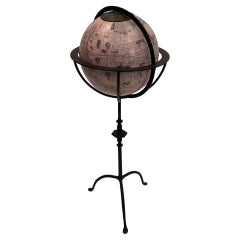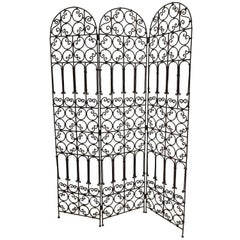Wrought Iron Home Accents
to
9
45
28
73
18
10
6
5
2
1
1
1
1
1
1
11
8
54
11
28
3
2
1
5
2
6
4
2
7,609
2,526
2,393
1,020
717
53
23
10
9
7
73
73
73
3
2
2
2
1
Material: Wrought Iron
Hand Carved Large Pine Trunk, circa 1800
Located in Round Top, TX
It is the hand-carved elements that make this trunk or "coffer" so impressive. Please examine the close up photos to appreciate the craftsmanship that went into the detailed carvings...
Category
Early 19th Century German Gothic Revival Antique Wrought Iron Home Accents
Materials
Wrought Iron
Handsome Freestanding Globe on Wrought Iron Base
Located in Hopewell, NJ
Tall freestanding globe on hand wrought iron stand with neutral colors.
Category
1960s Italian Vintage Wrought Iron Home Accents
Materials
Wrought Iron
Wrought iron three panel folding screen with bumblebee insect decoration
Located in Ferndale, MI
Unique whimsical and organic in design wrought iron three panel screen . Lacquered steel with bumblebee / insect decoration . Wings of the bee are decorated in cane the body is glas...
Category
Mid-20th Century American Mid-Century Modern Wrought Iron Home Accents
Materials
Wrought Iron
A Large Brutalist Iron and Desert Glass Sculpture Screen Paul Evans Style
By Paul Evans
Located in Lambertville, NJ
A striking brutalist hand forged and welded wrought iron and dessert glass sculpture screen in the manner of Paul Evans. Good original condition, from...
Category
1970s American Brutalist Vintage Wrought Iron Home Accents
Materials
Wrought Iron
Hand-Forged Iron Three Panels Folding Moorish Screen
Located in Moreno Valley, CA
Hand-forged folding Moroccan screen with three panels decorated with Moorish designs.
Classic and elegant Art & Craft this highly embellished, detailed folding screen divider in the Mediterranean Spanish style would embellish any room, garden or wall, Santa Barbara style.
Could make an amazing headboard.
Three panels with Moorish designs in repeat.
Heavy and well-made original condition.
Each panel: 68.5" high, 15.75" wide
Folds up for easy storage.
Rustic Spanish colonial style wrought iron window grill...
Category
20th Century Moroccan Moorish Wrought Iron Home Accents
Materials
Wrought Iron
$1,850 / item
Room Divider by Fred Leyman
By Fred Leyman
Located in Stockholm, SE
Spectacular sculptural room divider by Fred Leyman, custom-made for Majorna Library in Gothenburg in 1963. This piece is one of four that are each unique, made from wrought iron and hardened leather. The room dividers were granted substantial public interest and the studies for them were subsequently exhibited at Liljevalchs Konsthall in 1966. They were returned to the artist in the 1990s and acquired by Nordlings from the Leyman family in 2016.
Fred Leyman was a Swedish artist, schooled at the renowned Valand Art Academy in Gothenburg during the 1950s. Leyman worked in a distinctly modernist style influenced by the international modernist movement, music, political ideas and the environment in which he lived. He is best known for his around 40 large-scale sculptures erected in public spaces in Gothenburg and other parts of southwestern Sweden.
Fred Leyman lived on the island of Orust with his wife and children, in accordance with what he found to be ”a good life” close to nature on a small farm with sheep and horses. He was also deeply interested in music, particularly traditional folk music. Both the open, marine landscape of Orust and the rhytmical qualitites in music were vital forces in his artistry and in the development of his personal style. Leyman used iron and steel and sometimes wood and leather in his sculptures. These are characterized by sharp and billowing graphic lines and the use of negative space, seemingly always reaching somewhere. It is an expression striking the perfect balance between abstract and concrete.
Leyman’s materials of choice were particularly suitable for large and sustainable...
Category
1960s Swedish Mid-Century Modern Vintage Wrought Iron Home Accents
Materials
Wrought Iron
$22,286
Hand Forged Iron Moorish Folding Screen
Located in Moreno Valley, CA
Hand forged folding Moroccan iron screen with three panels decorated with Moorish designs.
Classic and elegant Art & Craft this highly embellished, detailed folding screen divider in the Mediterranean Spanish style iron art work would embellish any room, garden or wall, Santa Barbara style.
Could make an amazing headboard.
Three panels folding iron screen with Moorish designs in repeat.
Heavy and well-made original condition.
Each panel: 68.5" high, 15.75" wide
Folds up for easy storage.
Hand forged heavy wrought iron screen divider by skilled Moroccan artisans in Marrakech Morocco.
Rustic Spanish colonial style wrought iron window grill...
Category
20th Century Moroccan Moorish Wrought Iron Home Accents
Materials
Wrought Iron
Twentieth century travel trunk made of wood leather and iron
Located in Cesena, FC
Twentieth-century travel trunk made of leather wood and iron,
dating from the early 1900s this large trunk is of fine workmanship.
Made of solid forest green lacquered wood, this tr...
Category
Early 1900s Antique Wrought Iron Home Accents
Materials
Brass, Wrought Iron
Art Deco Wrought Iron Fire Screen
Located in Saint-Ouen, FR
Art Deco wrought iron fire screen, with golden antelope, double sided.
Measures: Thickness 1.5cm.
Category
1930s French Art Deco Vintage Wrought Iron Home Accents
Materials
Wrought Iron
Two art deco room dividers, decorated with arrows and ropes circa 1940
Located in Saint-Ouen, FR
Two art deco room dividers, decorated with arrows and ropes in lacquered and gilded metal, circa 1940
Each roomm divide measures 63"x56" (160x141 cm)
so for the two rooms divide 63"x...
Category
1940s French Art Deco Vintage Wrought Iron Home Accents
Materials
Wrought Iron
Wrought Iron and Wood Mediterranean Modern Folding Screen or Divider
Located in Buffalo, NY
Wrought iron and wood (balls) Mediterranean Modern folding screen or divider. Wonderful bronzed verde green patina, bi-fold, hand delivery availab...
Category
Mid-20th Century American Mid-Century Modern Wrought Iron Home Accents
Materials
Wrought Iron
Art Deco Fire Screen Attributed to Paul Kiss
By Paul Kiss
Located in Sagaponack, NY
An Art Deco wrought iron fire screen having hammered and gilded surface work and a central motif depicting a vase holding a bouquet of flowers. Attributed to French master metalworke...
Category
1930s French Art Deco Vintage Wrought Iron Home Accents
Materials
Wrought Iron
French Mid-Century Modern Neoclassical Faux Bamboo Gilt Iron Screen by Bagues
Located in New York, NY
French Mid-Century Modern neoclassical screen / room divider in gilt wrought iron faux bamboo by Maison Baguès, circa 1940-1950. The elegant piece i...
Category
Mid-20th Century French Mid-Century Modern Wrought Iron Home Accents
Materials
Wrought Iron
Recently Viewed
View AllMore Ways To Browse
Louis Vuitton Opera
Louis Vuitton Wardrobe Trunk
Antique Chinese Camphor Wood Trunk
British Leather Trunk
Louis Vuitton Brown Hat
Leather Dome Trunk
Victorian Steamer Trunk
Antique Padlock And Key
Courier Trunk
English Steamer
Hats Steamer
Italian Travel Trunk
Nailhead Trunk
Travel Trunk Italy
Trunk On Wheels
Upholstered Trunk
Antique Chinese Leather Trunks
Antique Embossed Trunk





